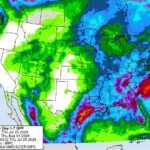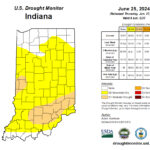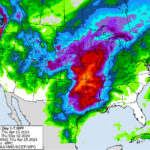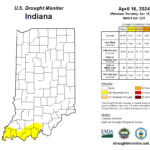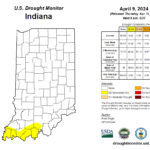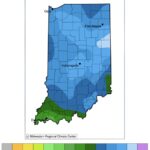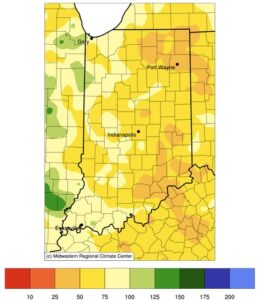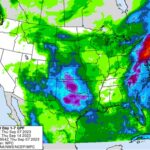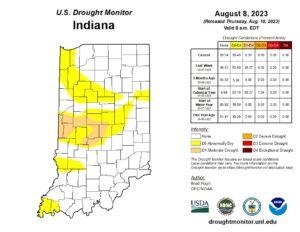Several weeks ago, Indiana received enough rain to eliminate drought across the state, leaving behind just a few counties in Abnormally Dry (D0) status. Fortunately, this week has been relatively quiet, allowing many areas to alleviate flooding issues. The U.S. Drought Monitor kept those Abnormally Dry areas nearly the same this week (Figure 1), so[Read More…]
Last week, temperatures were higher than normal, and the lack of precipitation was causing lawns to turn brown, creek and lake levels to drop, and some crops to start showing stress. The U.S. Drought Monitor introduced Abnormally Dry (D0) conditions across much of the state with concerns that a drought could be right around the[Read More…]
There is some very exciting news this week for Indiana with respect to the U.S. Drought Monitor. For the first time since April 25, 2023, the entire state is void of any Abnormally Dry (D0) or Drought (D1-D4) conditions. I would include the map, but … drumroll, please … there’s nothing to show! This is[Read More…]
There was an interesting conversation among drought experts this week about how best to communicate drought, particularly when surface conditions appear so saturated. I thought of Indiana a lot during this discussion because with all the rain the state has received over the last several weeks (over twice the normal amount!), there is localized flooding,[Read More…]
Something exciting happened on April 8th that many of you might be glad is over and no longer filling your news feed – the total solar eclipse. The Indiana State Climate Office, however, is now getting a chance to dig into the data collected from the Purdue Mesonet – a collection of 14 weather stations[Read More…]
An old saying predicts that March will go out “like a lamb”. Another saying predicts April’s wetness with “April showers bring May flowers”. A lot seems to have happened across Indiana since April began, but March finished the month with below-normal rainfall (except for the northern counties) and above-normal temperatures. Does this describe conditions that[Read More…]
Precipitation is one of the most variable weather phenomena with such an incredible local impact on communities. Too little can lead to drought and water supply issues, whereas too much can lead to flooding and infrastructure damage. Across Indiana, there are approximately 120 volunteer observers (Figure 1) who provide daily temperature and precipitation data to[Read More…]
To say the last few months have been dry is a bit of an understatement. Since August 1st, only a sliver of Newton and Benton counties (northwest Indiana) and the tiniest speck of Warrick County (southwest Indiana) have had above-normal precipitation. Most of western Indiana has been near (but below) normal, while the rest of[Read More…]
Wednesday, September 6th, was the first day in what seemed like a long, long time that rain fell across most of Indiana. Amounts ranged from a trace to around an inch. Where the rain fell was incredibly spotty (i.e., no rain within a mile or two of significant rain), highlighting the very localized nature of[Read More…]
6Drought and abnormally dry conditions continue to improve across most of Indiana (Figure 1). There seem to be a few counties – particularly along the western border – that have not been getting as much rain as elsewhere. Those areas are still at least abnormally dry through August 8, 2023. However, additional rain events over[Read More…]

